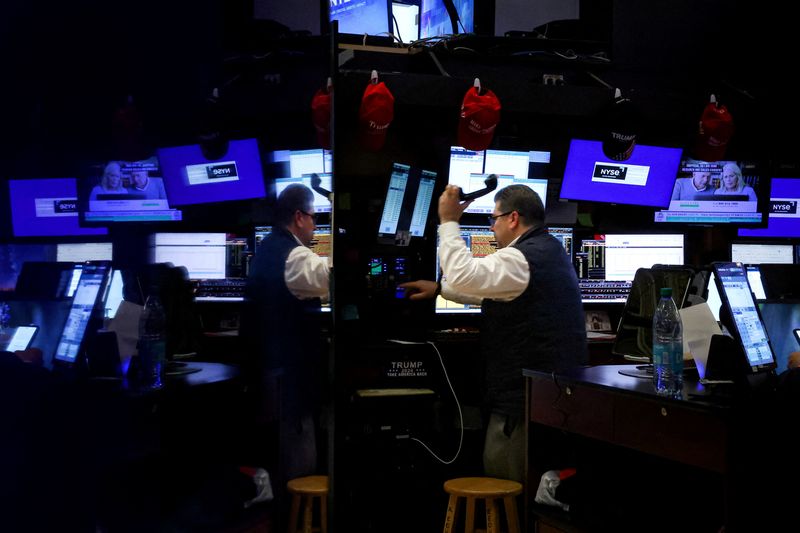Select Language

U.S. stock futures point higher following the Senate’s passage of a behemoth fiscal bill that holds President Donald Trump’s signature legislative agenda. The measure now moves to the House of Representatives, with Republicans facing an impending deadline to bring the bill before Trump to be signed into law. On the economic calendar, private payrolls data could provide a fresh glimpse into the state of the American labor market.
1. Futures higher
U.S. stock futures edged higher on Wednesday, as investors assessed the U.S. Senate’s now-approved version of a massive tax-cuts and spending package and kept tabs on the outlook for interest rates and tariffs.
By 03:33 ET (07:33 GMT), the Dow futures contract had inched up by 127 points, or 0.3%, S&P 500 futures had advanced by 17 points, or 0.3%, and Nasdaq 100 futures had climbed by 56 points, or 0.2%.
The main indices were mixed in the previous session, with traders eyeing a more hawkish reading of U.S. hiring and a smaller-than-anticipated contraction in manufacturing sector activity.
But the major story revolved around the fate of Trump’s so-called “One Big Beautiful Bill,” which, after narrowly passing the Senate, now moves to the House of Representatives for final approval -- with a self-imposed July 4 deadline to have the legislation on Trump’s desk looming large.
2. House to take up Senate’s version of Trump-backed fiscal package
Still, it remains uncertain whether the Republican lawmakers currently trying to shepherd the bill through Congress will be able to meet that date.
The House is expected to take up the Senate’s updated text on Wednesday, although some pushback from more fiscally-conservative GOP legislators is predicted to emerge.
Throughout the drawn-out process of passing the bill, some Republicans have balked at its potential impact on the country’s finances. Nonpartisan observers have flagged that the measures, which include the extension of Trump’s 2017 tax cuts, new tax reductions, and increased spending on defense and border security, will end up expanding the federal debt pile by over $3 trillion.
Despite the projected uptick in U.S. obligations, Treasury markets have reacted in a relatively muted manner, “cushioned by hopes” that the Federal Reserve may decide to slash interest rates in the coming months, analysts at ING said in a note to clients.
3. ADP jobs data ahead
The trajectory of Fed policy will likely be front and center when the latest monthly gauge of private payrolls is released on Wednesday.
Economists expect the figure in the ADP National Employment Report to rise to 99,000 in June, up from 37,000 in the prior month.
Data on Tuesday showed that while job openings unexpectedly ticked up in May, hiring weakened, indicating a possible cooling in an otherwise resilient labor picture. Further insight into the health of the labor market is due to come on Thursday, when the all-important nonfarm payrolls report is scheduled to be unveiled.
Pushing for maximum employment, along with corralling inflationary pressures, has long been a key mandate for Fed policymakers. Labor market demand has shown signs of receding while price gains have recently been relatively benign, although central bank officials have largely backed a wait-and-see approach to further interest rate changes, citing uncertainty over the effect of sweeping U.S. tariffs on the wider economy.
4. Trump hints at India trade deal with tariff pause deadline looming
The levies have been a major focus for markets, especially with the expiration of a pause to Trump’s punishing "reciprocal" duties just days away.
Trump administration officials have been carrying out negotiations with a host of nations during the delay, yet the White House has displayed little progress in securing fresh agreements.
On Tuesday, Trump told reporters that he believed India was ready to ink a trade deal with the U.S. that would help American companies and lower the country’s tariffs. India faces an impending 26% levy rate on July 9, when Trump’s reciprocal tariff delay ends.
"Right now, India doesn’t accept anybody in. I think India is going to do that, if they do that, we’re going to have a deal for less, much less tariffs," he said.
However, Trump also hinted that he may not choose to extend the deadline -- and would simply send out letters telling individual nations their tariff rates.
5. Oil subdued
Crude prices were little moved Wednesday, as traders digested progress towards an Israel-Hamas ceasefire and a build in U.S. inventories ahead of an upcoming OPEC+ meeting.
At 03:32 ET, Brent futures inched up 0.1% to $67.16 a barrel and U.S. West Texas Intermediate crude futures were unchanged at $65.45 a barrel.
President Trump on Tuesday evening said Israel had agreed to the conditions needed to finalize a 60-day ceasefire with Hamas, while also urging the Palestinian group to accept the deal.
Data from the American Petroleum Institute showed on Tuesday that U.S. oil inventories grew 0.68 million barrels in the week to June 27, a build that followed five weeks of deep, outsized draws in U.S. oil stockpiles, and raised some questions over fuel demand in the travel-heavy summer season.
The official government inventory report is due later on Wednesday.

